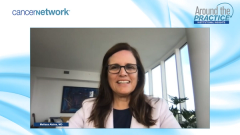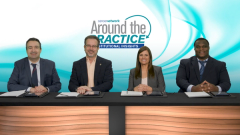
Non-BCMA Targeting Therapies in Multiple Myeloma
A brief review of talquetamab, a novel agent in the setting of relapsed/refractory multiple myeloma that targets GPRC5D.
Episodes in this series

Transcript:
Melissa Alsina, MD: Ken, maybe you can talk about talquetamab and the MonumenTAL study that was presented at ASH [American Society of Hematology Annual Meeting].
Ken Shain, MD: We talked about BCMA, the B-cell maturation antigen. There are other targets on the surface of myeloma cells making them specific. GPRC5D is another target, which is a G-protein-coupled receptor that’s unique to myeloma plasma cells. It’s the same concept: direct CD3 binding and the GPRC5D binding bringing T cells directly to the myeloma cells for the destruction of the myeloma cell, whether it’s peripheral or bone marrow T cells coming from the periphery. The bottom line is that from a response rate perspective, the data were just as good or even a little better. They were within the same realm—around 73%, which is highly effective. We’re learning that it may bring another set of adverse effects that we have to worry about. There were some issues with ageusia, or loss of taste; nail-biting issues; epidermal issues, which were the major problem that we have to learn how to deal with. Those are things we’re going to learn. But there are new therapies, and those are hopefully going to be improved in the not-too-distant future as an option.
Back to sequencing, do we give that before or after? Is it a different target? Is it going to be affected by the same mechanism of action? Is the target important? These are all questions. We’re going to have to come up with answers, and I don’t know if we have them yet. My memory of the study is that there wasn’t a lot of prior BCMA, so I don’t think we have that built in. There may have been some, but I don’t remember a lot of the data saying there was enough to make any difference. These are questions we’ll have to answer. The big thing is that this is another important target that’s very plasma cell specific, with a unique set of adverse effects, but it has great response rates in that same relapsed/refractory patient population. Those are the high-level things. Do you want to add anything, Brandon?
Brandon Blue, MD: As these therapies come out, how do we make sure the people who need them the most get access to these things? At our center, as our familiarity goes up, our availability to convey that to local doctors in the community should go up as well. We should say, “We feel comfortable with 2 novel therapies. We have these available. Refer your patients to us.” But at some point, it’s going to come back [with advice on] how you can give it in your community. It’s going to take some time for that because people want to give medications and things they feel familiar with and comfortable managing not only the drug itself but also the toxicities. As these medicines become more available, because they’re still coming, there are pipelines of more these novel therapies coming. But that should be the big push: it’s nice to give it at some of these academic centers, but to make the biggest impact and move the needle in myeloma care, it has to be something that can be given at somebody’s backdoor.
Transcript edited for clarity.
Newsletter
Stay up to date on recent advances in the multidisciplinary approach to cancer.






















































































